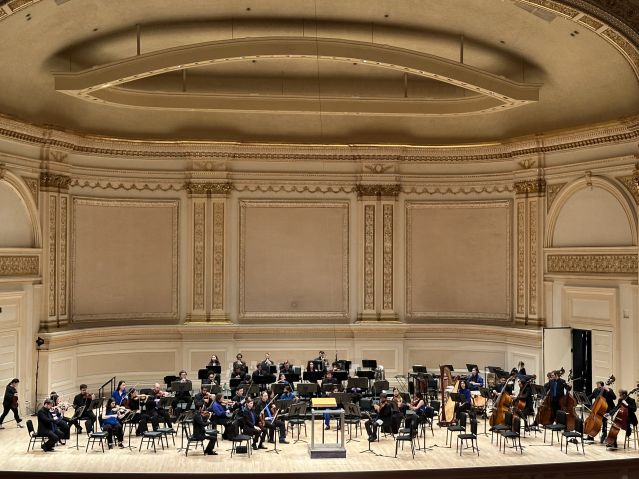Education
What We Can Learn From Attending a Live Classical Concert
Concert hall as an experimental lab.
Updated May 12, 2024 Reviewed by Ray Parker
Key points
- Classical music is alive and well, although its future direction is open to interpretation.
- We can learn much from the performers and conductors during a live performance.
- The concert hall is an experimental lab to exercise our observation and imagination and gain insights.

What is classical music’s place today? Will there still be an engaged audience for repertoires of the past centuries? The conductor, Leon Botstein, didn’t seem to hold high expectations for The Orchestra’s Now’s NYC premiere of lesser-known or newly discovered works composed in the past 150 years at Carnegie Hall when he half-jokingly said that given the concert program, he expected zero attendance. Contrary to that expectation, the orchestra crew was pleasantly surprised by a huge hall of audience waiting to experience lesser-known works composed by obscure figures in the composing scene who are better known for their virtuosic performance.
Performers—Role Models for Techniques, Artistic Expressions, and Interpretations
Taking music lessons is the default way of improving techniques when we rely on teachers to model for us and provide instantaneous feedback on our faulty posture or movement. However, in addition to relying on teachers to improve all aspects of our playing, if we are to exercise our observational power, we sometimes find our questions answered by the performers at a live concert.
Students of music can improve their techniques by observing a soloist executing virtuosic techniques such as double harmonics. Nikita Boriso-Glebsky, the violin soloist for the final concert of the 9th season Carnegie Hall classical concert series, for instance, demonstrated how to execute upbow staccatos at a fast speed efficiently, sustain the tone quality of long notes by seamlessly changing bow directions at the frog and tip, produce variegated tonal colors by varying the bow speed, contact points of the bow with the string, and the bow pressure, vary the speed and dynamics of trills and vibratos, and coordinate bodily movement during fast-string-crossing, balance the violin during a long movement, and how to “dance” with the orchestra during moments when the soloist concluded their part while the orchestra is being featured. Many of these details and nuances can be difficult to put into words.
However, perhaps most importantly, at live concerts, the performers showcased how they interpreted their concert pieces and modeled artistic expressions for us in real time in an immersive environment that visual and audio recordings often cannot fully capture. For instance, on the May 8 concert, titled Violinists as Composers, soloist Boriso-Glebksky concluded his lion's share of the concert program with a fast and furious Encore—the final movement of Ysaÿe sonata No. 2, IV. Les Furies – Allegro furioso. During the encore, Boriso-Glebksky demonstrated how taking an unexpected strategic pause when transitioning to a different section of the music where there is no written notation of rest can enhance the audience’s anticipation and appreciation of the tonal color change—in this instance, from the percussive double-stoppings to the glossy ponticello sound.
Concert Hall—A Venue for Honing Critical Listening Skills
Minor details are often not captured by recording devices. Even high-definition audio recordings may not be able to faithfully represent nuanced sound produced by an acoustic solo instrument or the harmonic overtones generated by different types of instruments.
Attending a live performance provides the audience with a great ear training opportunity. During the concert, we can practice deciphering the musical form of a composition, observing the instrumentation and stage setup, listening for modal changes, making educated guesses about compositional devices deployed, such as chord progressions used to heighten some psychological effects, and identifying direct quotations of other composers’ works or indirect allusions to widely known melodic materials.
In the case of the recently discovered Ysaÿe violin concerto in d minor, the quotation of the opening of Wieniawski Violin Concerto in F-Sharp Minor and in the case of the Encore, Les Furies, the allusion to Dies Irae, can pique listeners’ curiosity to explore the works further after the concert. This is because these quotations and allusions make the pieces sound refreshing and familiar at the same time. The concert hall enables the audience to listen critically to elements of music that they are familiar with or have background knowledge of.
Live Concert—A Fertile Ground for Letting One’s Imagination Run Free
The concert hall is also a fertile ground for exercising tonal, visual, and storytelling imagination. The audience can close their eyes for a few seconds and imagine how the performers executed the bow strokes—e.g., which part of the bow the performers used, how they distributed their bow across accented vs. off-beat notes, and how they varied bowing patterns to create moving musical phrases, how they placed their bows along the various contact points between the bridge and fingerboard to create special aural effects (e.g., sul tasto vs. ponticello) and weaving interesting “storylines” within the music.
The audience can also imagine journeying across time to different parts of the world where the compositions germinated. While the concert program note and the composer’s bio offer a glimpse of the major sources of inspiration for the compositions and the larger historical backdrop behind their music, there is much room for the audience to reimagine the composers’ artistic intention, infer what the composers’ internal narratives, and anticipate how the music will unfold in real time, especially when the audience is attending a premiere performance of the works.
A third way the audience can exercise their imagination is by considering how the prevailing mood of the piece might change had the composition been performed at a slower tempo and how the soundscape of a work might change if the conductor decides to bring out certain sections of the orchestra more while dimming others. The concert hall lets the audience experience the best of both worlds—the freedom to let their musical imagination run free and the ability to place their imagined version vis-à-vis the live performance for instantaneous comparison and feedback.
Postlude
What is classical music’s place today? The answer seems to be alive and well. Even though the concert hall is being populated by more of an aging audience, there is certainly no lack of youngsters who are music students and budding musicians.
What is classical music’s place in a rapidly changing and unpredictable future? With the digitalization of video and audio recordings and the emergence of artificial intelligence (AI)-based music synthesizers, there are good reasons to feel concerned about the demise of classical music as is known and practiced in the centuries past. However, in fashion, we often see the return of classic design patterns, such as the polka dot, which some say is timeless. Some themes are considered universal in the humanities and keep repeating themselves throughout human history. They are mirrored by the stories of generations of writers without getting outdated. Can we infer the same for the future of classical music?
Or, will we turn our backs on the intellectual legacy from the previous centuries? Will we instead embrace video games, TV commercials, and electronically synthesized music as the mainstream venues for artistic expression and entertainment? With a healthy dose of optimism, it is possible to imagine a brighter future for the world of classical music than is typically portrayed in social media if efforts have been made to educate, engage, and empower the audience along their musical journey.




